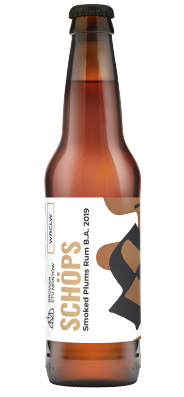In the Christmas edition of our WRCLW Schops, we rediscover history by combining it with the latest brewing trends! Schöps is a wheat symbol of Wrocław, whose recipe we recreated years later based on the descriptions from the chronicles! In B.A, version it went to oak rum barrels and aged with dried smoked plums. The sweet and sour beer profile has been complemented with the taste of oak soaked in rum. The aroma of nutmeg, honey and warm bread, characteristic for the basic version, has been enriched with notes of dried plum, focal smoke, cold smoked ham, dark dried fruit (blackberry, cherry), oak and rum. This is the beer history of Wrocław – rediscovered!
Style
The wheat symbol of Wrocław brewed in Wrocław since the 16th century – Schöps was considered to be one of the leading beers in Europe at that time. The history of the beer vanished two centuries later with no recipe being preserved. Together with an international team of experts, we’ve ventured to recreate the style based on chronicle entries regarding its taste and the available knowledge on traditional brewing methods in the Lower Silesia region. The beer was of unique honey-nutmeg flavour. As it might not have been too hoppy, the beer’s sweetness could have been balanced with slight acidity coming from lactic acid bacteria living in the oak barrels used for fermentation and ageing processes.
Malts/extract:
The majority of wheat malts used in the production of the beer account for its honey-nutmeg aroma. We have used over 80% of light, dark and chocolate wheat malts to recreate the flavour of the beer. The caramel and melanoid barley malts have been added to achieve the fullness and enrich wheat malt aromas. The distinguished taste has been achieved thanks to addition as many as… 6 types of malts and the traditional decoction mashing process. Schöps was considered to be a stronger beer, slightly lighter than the German Bockbier and so we have raised extract to 14.5%.
Hops:
Schöps might not have been a particularly hoppy beer style – all the hops used for its production were most probably local – one of them was the oldest known hop varieties – Nowotomyski. Despite attempts at reintroduction, it is not yet available in adequate quantities, so we decided to use German Tettnanger hops, which is a traditional, noble hop from the region associated for centuries with the cultivation of hops – the area of the city of Tettnang. This hop is suitable for both bitterness and aroma hopping and has a pleasant herbal and floral aroma.
Bacteria:
Schops has never been intentionally cultured with lactic acid bacteria. Thermophilic strains of these bacteria naturally inhabited the wood pores in oak barrels in which the beer was fermented and aged. Slight acidification of the beer meant that the sour taste counterbalanced the high sweetness of Wrocław’s Schops. Acidification also influenced the durability of this beer, because it`s a natural method of protecting food against spoilage. To obtain this effect, so-called “sauergut” ( wort acidified with bacteria lactic acid) has been added to the wort. We used: Lactobacillus lactis, Lactococcus lactis, Lactobacillus plantarum, Lactobacillus delbrueckii subsp. bulgaricus that are also present in daily products like sourdough, kefir or yogurt.
Ageing in rum barrels:
Beer ageing is a fascinating process, which is being studied by scientists. During the aging process beer oxidizes: taste and aroma balance, tones of port wine, sherry, dry fruit (plums, raisins, cherries) and honey appear. Tannins released by oakwood account for certain bitterness that balances the sweetness of Schöps. Caramel and smoked wood compounds produce vanilla, coconut and spicy tones.
The barrels have an interesting story themselves. First they were used for storing American Bourbon, then rum and finally WRCLW Schöps. They are very rich and aromatic. Jamaican rum is exceptional in the sense of releasing exceptional aromas of spices, marzipan, tropical fruit, intense vanilla, orange peels, cane sugar and molasses. This aroma enhances the historic style from Wrocław.
Beer aged in smoked plums:
The aging of beer is an amazing process, where beer is oxidized, which means that the taste and aroma harmonize and the notes of rum, sherry and dried fruit (plums, raisins, cherries) appear in it. In addition, the alcohol notes slightly milder, and the wood notes itself are washed out.
– tannins – defined as the taste of wood, which introduce a characteristic astringency that counteracts the sweetness of beer.
– caramels and so-called Maillard reaction compounds that are formed in the process of tanning the barrel (they affect the characteristic color of dark Rum)
– Lignins, after several transformations, transform into vanillin – which gives the characteristic vanilla notes, especially from American oak the entire group of phenols is created, which are responsible for spicy aromas of clove, cinnamon, coconut and even roasted.
Finally, the beer is getting more concentrated while the water evaporate from a barrel. Of course, the beer is also taking on the character of alcohol that was kept in the barrel before. And rum barrels are very interesting! Rum has a wonderful aroma of spicy, marzipan, tropical fruit, intense vanilla, orange peel, brown sugar and molasses, which ideally enriches our historical beer style.
- Style: Schöps (the Wrocław ram)
- Parameters
- Extract: 14,5 %
- Alcohol: 5,9 %
- IBU: 15
- Ingredients:
- Malts: wheat malts; barley malts: Pilsen, Munich I, wheat chocolate, caramel aromatic 280 E
- Yeasts: top fermentation S-04
- Bacteria: Lactobacillus lactis, Lactococcus lactis, Lactobacillus plantarum, Lactobacillus delbrueckii ssp. Bulgaricus
- Extra ingredients: smoked and dried plums
- Look: slightly cloudy; dark orange
- Aromas: plum; smoky (a bonfire, smoked ham); nutmeg; honey; toasted wheat bread; subtle vanilla and coconut, nutmeg, honey, toasted crust of wheat bread, dried cherry and cranberry, oak, rum, light sour notes and funky!
- Flavour:
- full-bodied malty
- plum, smoky
- slightly sour; sweet and sour finish with rum and oak notes aftertaste
- Serving temperature: 9-13 ⁰C
- Glass: Tulip, Sniffter
- Foodpairing:
Dishes: liver in plum sauce with raspberry demi glace, halloumi with plum jam and malty crumble
Cheeses: “Sudecki” regional cottage cheese; “Łomnicki” regional goat cheese
Dessert: brownie with cheesecake and raspberry mousse, ice cream with salty caramel and walnuts



